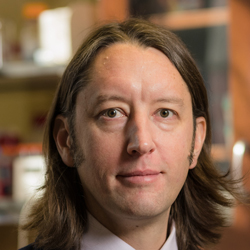Faculty DirectoryJulius Lucks

Margery Claire Carlson Professor of Chemical and Biological Engineering
Contact
2145 Sheridan RoadTech E154
Evanston, IL 60208-3109
847-467-5007Email Julius Lucks
Website
Centers
Departments
Chemical and Biological Engineering
Affiliations
PhD Program in Interdisciplinary Biological Sciences
Education
Miller Fellow Postdoctoral Associate, University of California, Berkeley, CA
Ph.D., Chemical Physics, Harvard University, Cambridge, MA
M.S., Chemical Physics, Harvard University, Cambridge, MA
M.Phil., Chemistry, University of Cambridge, Cambridge, UK
B.S., Chemistry, University of North Carolina, Chapel Hill, NC
Research Interests
Our research has led to fundamental contributions to our understanding of the molecular principles that enable biological systems to sense and adapt to changing environments, and to understanding how we can use these principles to engineer synthetic biological systems that benefit humankind. A focal point of our work is RNA – a fundamental component of all living systems that enacts genetic, regulatory and catalytic functions by folding into intricate shapes within cells. Through development of high throughput RNA structure/function measurement technologies, we have discovered new ways in which the complexity of RNA folding can be distilled into simple rules, which can be used to program RNA function. Combining these discoveries with cutting-edge cell-free synthetic biology techniques has allowed us to translate these discoveries into designing low-cost, on-demand diagnostic technologies that can detect water contaminants and pathogens. Our discovery-to-design research paradigm is now making possible a whole new toolkit based on synthetic biotechnology principles that has the potential to transform our world through tackling global challenges.
Our current research interests span a range of fundamental and applied questions. Within our RNA folding studies, we are asking questions about how changes in RNA sequence govern RNA folding dynamics that in turn govern RNA function. To address these questions, we are developing new high throughput RNA structure measurement techniques that feed into new computational RNA folding frameworks that can model the RNA sequence-dynamic structure-function relationship. An increasing interest is developing deep learning approaches for this task. In terms of biosensor engineering, we are interested in developing approaches to expand the range of compounds that can be detected, engineering cell-free genetic circuits that improve biosensor performance, and embedding sensors in materials for enhanced function. We pursue these fundamental developments in the context of sensing chemical contaminants in water, human and environmental samples, and pathogens in agricultural crops. In collaboration with social scientists, we are also interested in field testing our technologies with non-expert users, with recent projects including a large scale field trial of water quality tests in the Chicagoland area, and field trials of CRISPR-based crop pathogen detection in Kenya and Uganda.
Selected Publications
- Y. Li, T. J. Lucci, M. Villarruel Dujovne, K. J. Jung, D. A. Capdevila, J. B. Lucks (2025). "A cell-free biosensor signal amplification circuit with polymerase strand recycling." Nature Chemical Biology, doi: 10.1038/s41589-024-01816-w.
- A. S. Karim, D. M. Brown, C. M. Archuleta, S. Grannan, L. Aristilde, Y. Goyal, J. N. Leonard, N. Mangan, A. Prindle, G. J. Rocklin, K. J. Tyo, L. Zoloth, M. C. Jewett, S. Calkins, N. Kamat. D. Tullman-Ercek, J. B. Lucks (2024). “Deconstructing synthetic biology across scales: a conceptual approach for training synthetic biologists.” Nature Communications, doi:10.1038/s41467-024-49626-x.
- W. Thavarajah, P. Our, D. Awuor, K. Kiprotich, R. Aggarwal, J. B. Lucks, S. L. Young (2023). The accuracy and usability of point-of-use fluoride biosensors: a field study in Nakuru County, Kenya. npj Clean Water, 6, 5, doi:10.1038/s41545-023-00221-5.
- K. J. Jung, K. K. Alam, Chloé M. Archuleta, J. B. Lucks (2022). “Programming cell-free biosensors with DNA strand displacement circuits”.
- Nature Chemical Biology, doi:10.1038/s41589-021-00962-9.
- A. M. Yu, P. M. Gasper, L. Cheng, L. B. Lai, S. Kaur, V. Gopalan, A. A. Chen, J. B. Lucks (2021). "Computationally reconstructing cotranscriptional RNA folding from experimental data reveals rearrangement of non-native folding intermediates." Molecular Cell, doi: 10.1016/j.molcel.2020.12.017.
- J. K. Jung, K. K. Alam, M. S. Verosloff, D. A. Capdevila, M. Desmau, P. R. Clauer, J. W. Lee, P. Q. Nguyen, P. A. Pasten, S. J. Matiasek, J.-F. Gaillard, D. P. Giedroc, J. J. Collins, J. B. Lucks (2020). "Cell-free biosensors for rapid detection of water contaminants." Nature Biotechnology, doi: 10.1038/s41587-020-0571-7.
- W. Thavarajah, A. D. Silverman, M. S. Verosloff, N. Kelley-Loughnane, M. C. Jewett, J. B. Lucks (2019). "Point-of-use detection of environmental fluoride via a cell-free riboswitch-based biosensor." ACS Synthetic Biology, doi: 10.1021/acssynbio.9b00347.
- E. J. Strobel, L. Chang, K. Berman, P. D. Carlson, J. B. Lucks (2019). “A ligand-gated strand displacement mechanism for ZTP riboswitch transcriptional control.” Nature Chemical Biology. doi:10.1038/s41589-019-0382-7.
- E. J. Strobel, A. M Yu, J. B. Lucks (2018). "High-throughput determination of RNA structures." Nature Reviews Genetics, doi: 10.1038/s41576-018-0034-x.
- K. E. Watters, E. J. Strobel, A. M Yu, J. T. Lis, J. B. Lucks (2016). “Cotranscriptional Folding of a Riboswitch at Nucleotide Resolution”, Nature Structural and Molecular Biology, doi: 10.1038/nsmb.3316..
- J. Chappell, M. K. Takahashi, J. B. Lucks (2015). “Creating small transcription activating RNAs,” Nature Chemical Biology, doi: 10.1038/nchembio.1737..
- M. K. Takahashi, J. Chappell, C. A. Hayes, Z. Z. Sun, J. Kim, V. Singhal, K. J. Spring, S. Al-Khabouri, C. P. Fall, V. Noireaux, R. M. Murray, J. B. Lucks (2015). “Rapidly characterizing the fast dynamics of RNA genetic circuitry with cell-free transcription-translation (TX-TL) systems,” ACS Synthetic Biology, doi: 10.1021/sb400206c.